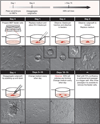Derivation of extraembryonic endoderm stem (XEN) cells from mouse embryos and embryonic stem cells
- PMID: 23640167
- PMCID: PMC3927835
- DOI: 10.1038/nprot.2013.049
Derivation of extraembryonic endoderm stem (XEN) cells from mouse embryos and embryonic stem cells
Abstract
At the time of implantation in the maternal uterus, the mouse blastocyst possesses an inner cell mass comprising two lineages: epiblast (Epi) and primitive endoderm (PrE). Representative stem cells derived from these two cell lineages can be expanded and maintained indefinitely in vitro as either embryonic stem (ES) or XEN cells, respectively. Here we describe protocols that can be used to establish XEN cell lines. These include the establishment of XEN cells from blastocyst-stage embryos in either standard embryonic or trophoblast stem (TS) cell culture conditions. We also describe protocols for establishing XEN cells directly from ES cells by either retinoic acid and activin-based conversion or by overexpression of the GATA transcription factor Gata6. XEN cells are a useful model of PrE cells, with which they share gene expression, differentiation potential and lineage restriction. The robust protocols for deriving XEN cells described here can be completed within 2-3 weeks.
Figures





Similar articles
-
Extra-embryonic endoderm cells derived from ES cells induced by GATA factors acquire the character of XEN cells.BMC Dev Biol. 2007 Jul 3;7:80. doi: 10.1186/1471-213X-7-80. BMC Dev Biol. 2007. PMID: 17605826 Free PMC article.
-
Conversion from mouse embryonic to extra-embryonic endoderm stem cells reveals distinct differentiation capacities of pluripotent stem cell states.Development. 2012 Aug;139(16):2866-77. doi: 10.1242/dev.078519. Epub 2012 Jul 12. Development. 2012. PMID: 22791892 Free PMC article.
-
Efficient derivation of extraembryonic endoderm stem cell lines from mouse postimplantation embryos.Sci Rep. 2016 Dec 19;6:39457. doi: 10.1038/srep39457. Sci Rep. 2016. PMID: 27991575 Free PMC article.
-
Extraembryonic endoderm cells as a model of endoderm development.Dev Growth Differ. 2013 Apr;55(3):301-8. doi: 10.1111/dgd.12036. Epub 2013 Feb 18. Dev Growth Differ. 2013. PMID: 23414197 Review.
-
Stem cells and lineage development in the mammalian blastocyst.Reprod Fertil Dev. 2007;19(1):111-8. doi: 10.1071/rd06125. Reprod Fertil Dev. 2007. PMID: 17389140 Review.
Cited by
-
Control of cardiomyocyte differentiation timing by intercellular signaling pathways.Semin Cell Dev Biol. 2021 Oct;118:94-106. doi: 10.1016/j.semcdb.2021.06.002. Epub 2021 Jun 16. Semin Cell Dev Biol. 2021. PMID: 34144893 Free PMC article. Review.
-
PDGFRα+ Cells in Embryonic Stem Cell Cultures Represent the In Vitro Equivalent of the Pre-implantation Primitive Endoderm Precursors.Stem Cell Reports. 2017 Feb 14;8(2):318-333. doi: 10.1016/j.stemcr.2016.12.010. Epub 2017 Jan 12. Stem Cell Reports. 2017. PMID: 28089671 Free PMC article.
-
Links between DNA Replication, Stem Cells and Cancer.Genes (Basel). 2017 Jan 25;8(2):45. doi: 10.3390/genes8020045. Genes (Basel). 2017. PMID: 28125050 Free PMC article. Review.
-
Highly efficient generation of blastocyst-like structures from spliceosomes-repressed mouse totipotent blastomere-like cells.Sci China Life Sci. 2023 Mar;66(3):423-435. doi: 10.1007/s11427-022-2209-3. Epub 2023 Jan 10. Sci China Life Sci. 2023. PMID: 36633710
-
Roles of MicroRNAs in Establishing and Modulating Stem Cell Potential.Int J Mol Sci. 2019 Jul 25;20(15):3643. doi: 10.3390/ijms20153643. Int J Mol Sci. 2019. PMID: 31349654 Free PMC article. Review.
References
-
- Schrode N, et al. Anatomy of a blastocyst: cell behaviors driving cell fate choice and morphogenesis in the early mouse embryo. Genesis. Published online; http://dx.doi.org/10.1002/dvg.22368 (25 February 2013). - DOI - PMC - PubMed
-
- Tanaka S, Kunath T, Hadjantonakis AK, Nagy A, Rossant J. Promotion of trophoblast stem cell proliferation by FGF4. Science. 1998;282:2072–2075. - PubMed
-
- Kunath T, et al. Imprinted X-inactivation in extra-embryonic endoderm cell lines from mouse blastocysts. Development. 2005;132:1649–1661. - PubMed
-
- Evans MJ, Kaufman MH. Establishment in culture of pluripotential cells from mouse embryos. Nature. 1981;292:154–156. - PubMed
Publication types
MeSH terms
Substances
Grants and funding
LinkOut - more resources
Full Text Sources
Other Literature Sources

